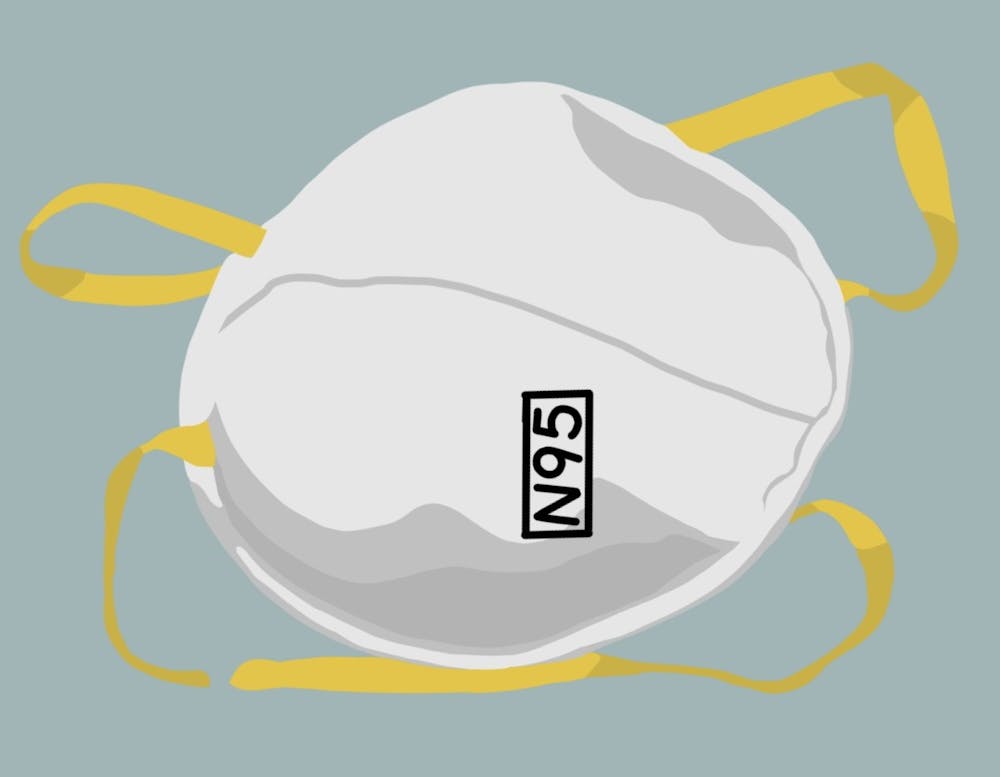This fall, the University Health System received over 38,000 N95 masks from the National Strategic Stockpile — a national holding of critical medical supplies managed by the U.S. Department of Health and Human Services. This was welcoming news for frontline healthcare workers and the University Health System, which has been trying to keep up with COVID-19 related demand for months. However, the 38,000 masks often had unusable straps that broke when stretched.
In the face of this new challenge, Adam Momper — a supply chain administrator at U.Va. Health — reached out to Dr. William Guilford, associate professor of biomedical engineering and assistant dean for undergraduate education, to see if Guilford could figure out a way to replace over 38,000 mask straps.
The two met in a parking lot where Momper presented the defective masks and described the nature of the problem to Guilford.
This project presented a unique engineering challenge, Guilford said, one that demanded complex coordination rather than pure innovation.
“It’s not like you’re dreaming — how do I invent this new way of doing something?” Guilford said. “It's more like — we just need substantial equivalence between what we can do and what exists.”
After the meeting, Guilford began identifying which materials would be best suited for the task, calculating the necessary amounts and sourcing them. According to Guilford’s estimates, he and his team needed 116,000 feet of non-latex elastic banding material and 230 pounds of cord locks to reassemble the 1,086 boxes of masks.
When the ordered materials, which only cost about 26 cents per mask, came pouring in, Guilford then had to address an even greater challenge — how to coordinate volunteers to assemble tens of thousands of masks in the middle of a pandemic. Guilford has been able to draw on over 35 undergraduate students and community members, who he was able to recruit through the Engineering department and contacts in the U.Va. Health System, to help assemble the masks. One such volunteer — second-year Engineering student Ailene Edwards — described the mask assembly as an opportunity to break out of the normal pandemic routine and do something different while also being able to contribute to a good cause.
“Professor Guilford makes it fun ... we just do what we can in the time frame we have,” Edwards said. “Slowly but surely we will get there.”
The great contribution of undergraduate students is not lost on Guilford, who emphasized their role in this project and many others.
“We sometimes call them partners in discovery,” Guilford said. “They are every bit as much of our labs as [post-doctoral students] and graduate students … undergraduates cannot only contribute, but they can contribute in vital ways.”
Momper echoed that appreciation for volunteers, as well as for Guilford himself.
“It’s just been true ingenuity, creativity and partnership across, but [Will] has really set the stage for us,” Momper said. “They have bent over backwards to find volunteers and space to do this work. They’ve been absolutely awesome.”
Thankfully, the University was able to source enough masks outside of the national stockpile so that the health system is not dependent on Guilford and his team to produce masks rapidly — although they have completed over 2,000 masks already. These surplus masks provide them the opportunity to take time and do the project right, providing a stable, long-term source of masks moving forward
When asked about the ongoing collaboration between U.Va. Health and the School of Engineering, Guilford emphasized that consistent positive collaboration and physical closeness between the two entities has made the great partnership possible.
“[We have] an unusually close relationship between us … summer opportunities for undergraduates, awesome capstone experiences for students, a ready source of clinical problems for us to work on as biomedical engineers”, Guilford said. “All that stuff benefits from U.Va.’s natural collegiality and proximity.”
Momper echoed Guilford’s sentiment that collaboration between the University and Health System is invaluable.
“[The pandemic] has shined a bright light on the valuable knowledge, resources and skills that we have across our greater footprint and the University being an academic medical center,” Momper said.
Guilford and Momper alike believe that the spirit of collaboration certainly benefits U.Va. Health moving forward in this pandemic, in which challenges require not only innovation but flexibility and effort. Guilford emphasized that while problem-solving and theory are vital to engineering, sometimes real world problems like this come down to effort and commitment.
“Sometimes it's not all about [complex] equations and everything else,” Guilford said. “It’s just a matter of doing it.”







